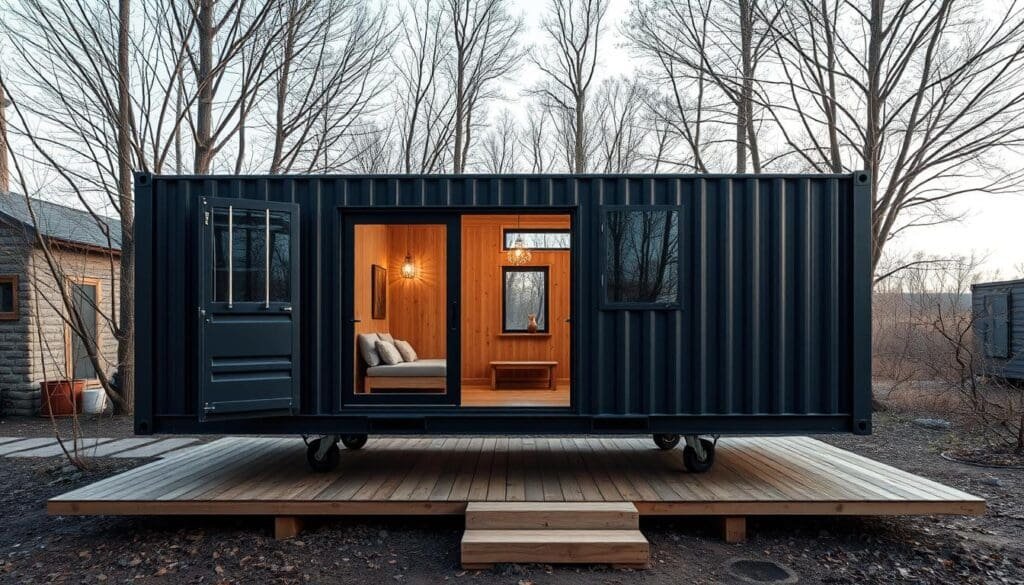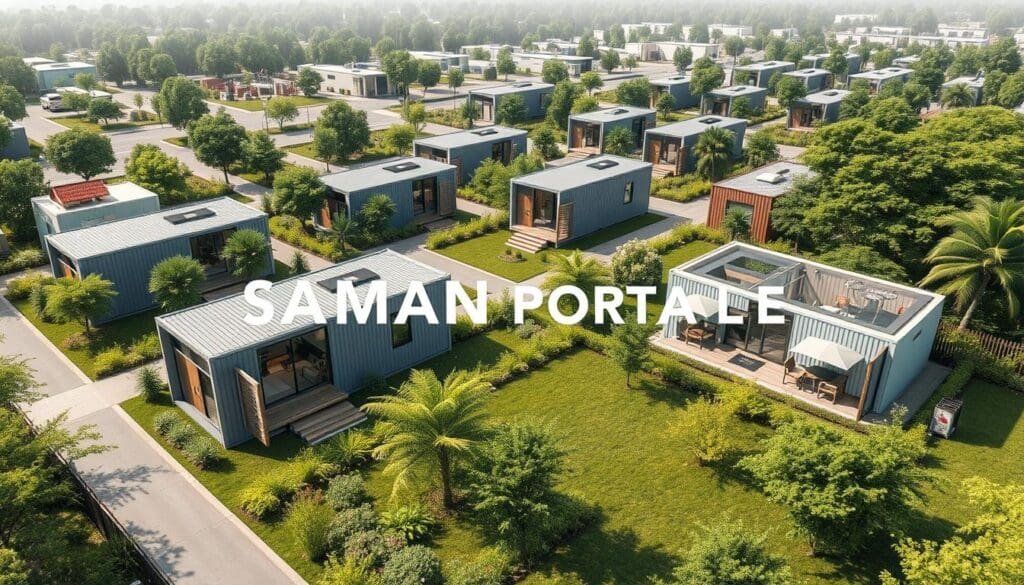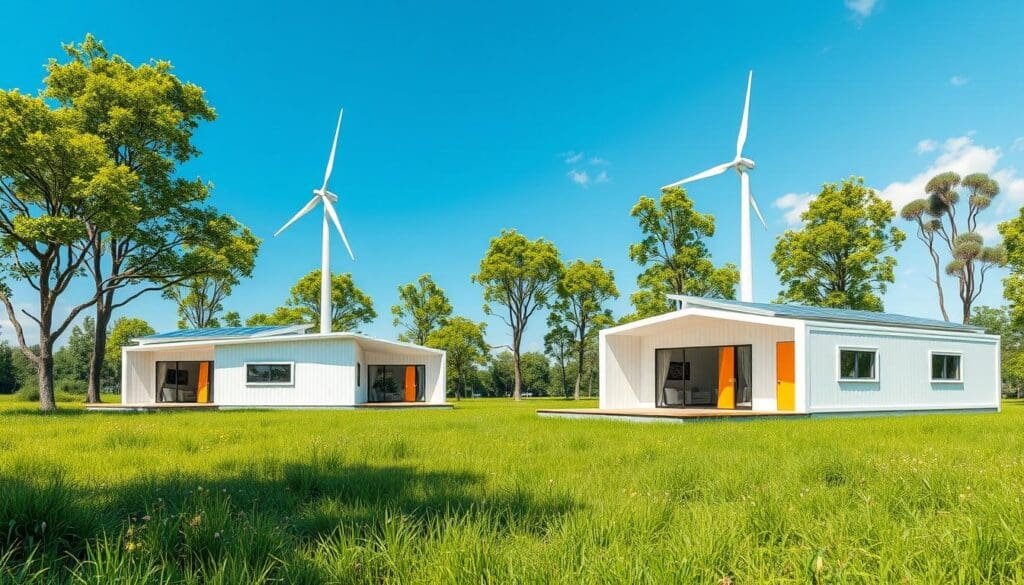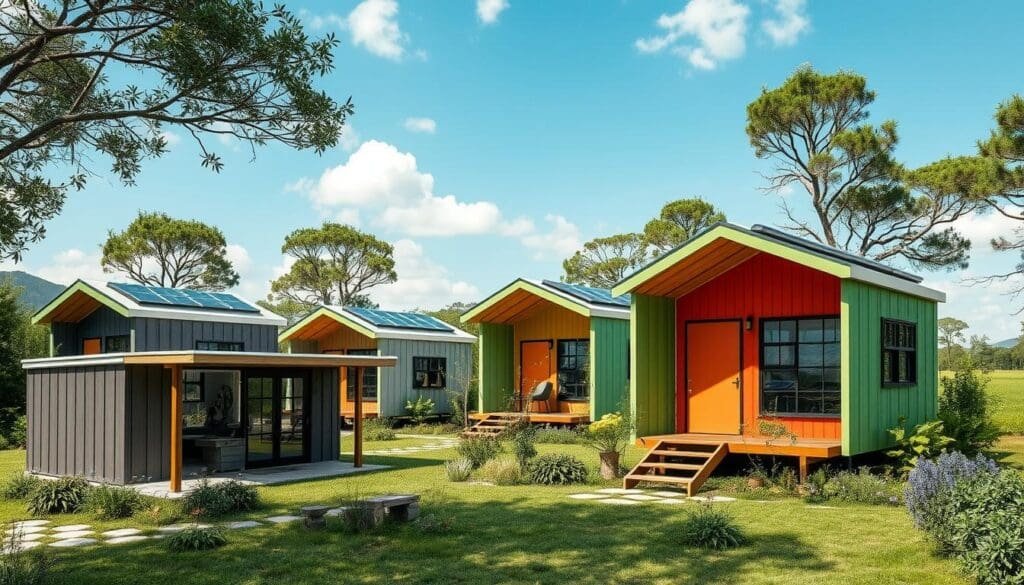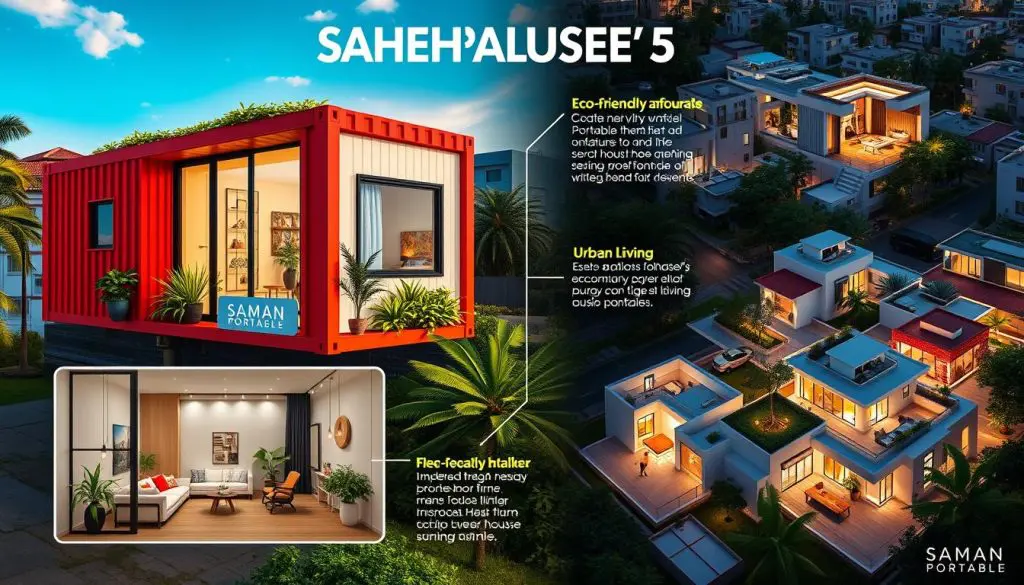Container House Building Plans: Create Your Dream Home
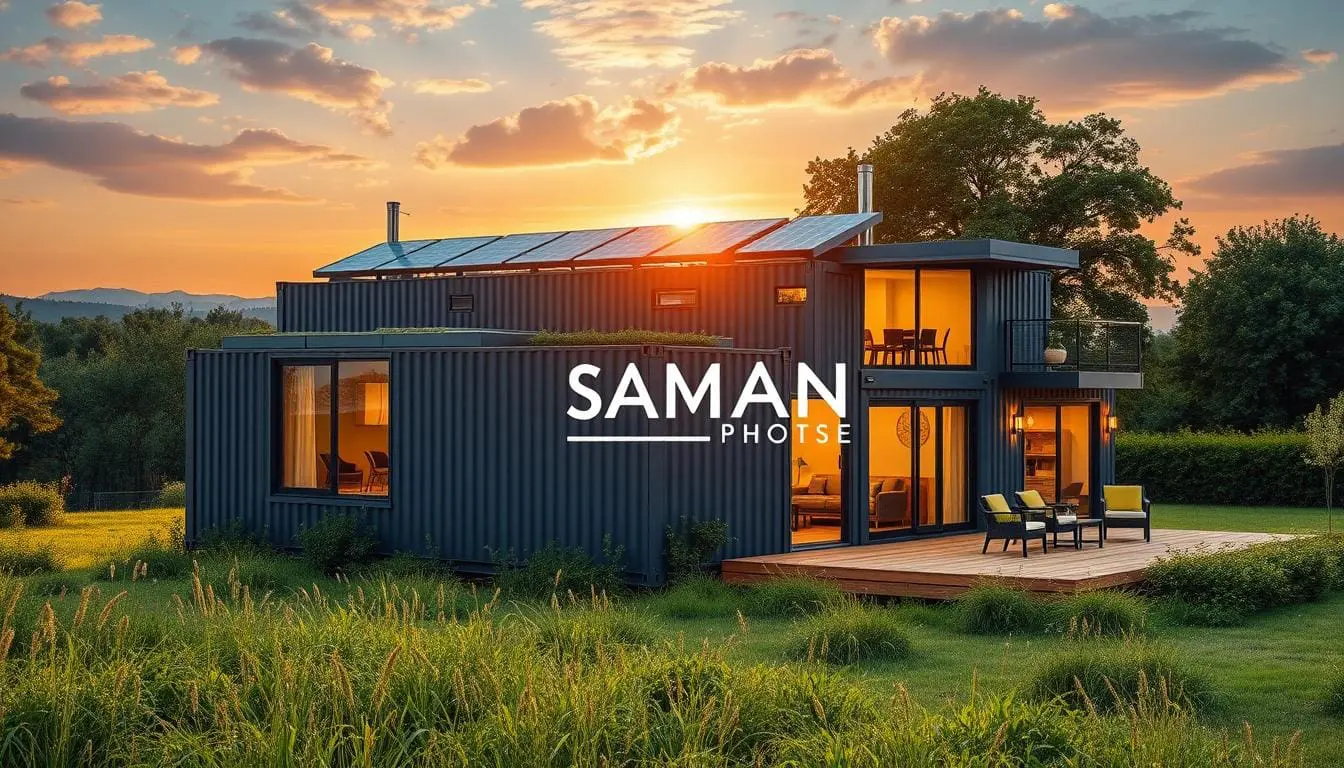
Ever thought about turning a simple shipping container into a beautiful, green home? Our guide reveals the secrets of portable cabin solutions and how to make the most of modular home cost. You’ll see how to mix eco-friendly designs with affordable, modern looks. This lets you build your perfect home.
For a detailed breakdown of expenses and valuable tips on budgeting your container home, check out our comprehensive guide on modular home costs. This resource dives into everything you need to know about pricing, helping you plan your dream home without breaking the bank.
Key Takeaways
- Discover the versatility of shipping container architecture and how to unlock its full potential.
- Learn about the various types of containers and their structural considerations for housing.
- Explore the benefits of container house living, including cost-effectiveness and sustainability.
- Gain insight into essential building plans, from single-container layouts to modular designs.
- Understand the crucial steps in site preparation, foundation requirements, and legal compliance.
Understanding Container Home Architecture
Container house design is a new way to live, thanks to modular home manufacturers. It uses shipping containers as a strong base for homes. This makes it easy to create homes that fit your needs.
Basic Container Structure and Modifications
Shipping containers are usually 20 or 40 feet long, 8 feet wide, and 8 or 9 feet tall. These sizes are great for starting a home design. Architects then change these containers to fit what their clients want. Beyond the structural changes, creating a comfortable and functional space inside requires thoughtful design. Discover inspiring ideas and tips for transforming interiors by exploring our comprehensive guide on container house interior design.
Types of Shipping Containers for Housing
- 20-foot containers: Perfect for small spaces like offices or guest rooms.
- 40-foot containers: The most used size for homes, offering lots of room.
- High-cube containers: These have an extra foot of height, making them versatile for different designs.
Structural Integrity Considerations
It’s important to make sure a container home is strong. Architects use welding and smart placement to keep it stable. They also plan carefully to add big windows and doors without weakening the structure.
Adapting Container Homes for Extreme Climates
Container homes have emerged as a popular housing solution due to their affordability and sustainability. For individuals and families looking to invest in affordable prefab homes, these structures offer unique advantages. However, adapting container homes for extreme climates requires careful planning and innovative design to ensure comfort and durability. With the right modifications, these homes can provide a safe haven, no matter the weather conditions outside.
When considering container homes in areas prone to extreme temperatures, insulation becomes a priority. Various insulation materials can be integrated into the container house interior design to manage heat and cold effectively. For instance, spray foam insulation works well in both hot and cold environments by creating an airtight seal. Additionally, reflective materials can be used on the exterior to deflect sunlight in the hotter months, while thermal curtains can help retain warmth during chilling winters. These design choices not only enhance comfort but also contribute to energy efficiency, reducing heating and cooling costs over time.
Moreover, the layout and orientation of the container are crucial in adapting to extreme climates. Strategic positioning of windows and the use of overhangs can provide natural ventilation and shading, minimizing the reliance on mechanical cooling or heating systems. Furthermore, many homeowners are opting for modular designs that allow for flexibility in expanding the living space as needed. This adaptability is particularly appealing for those in transitional phases, such as setting up a site office. By understanding factors such as the site office container price and potential expansion costs, homeowners can make informed decisions that accommodate their needs without breaking the bank.
For those exploring cost-effective yet climate-adaptive solutions, affordable prefab homes offer an excellent alternative. These homes combine durability, sustainability, and affordability, making them ideal for diverse weather conditions.
Knowing how container homes work lets people create unique and green living spaces. It’s all about mixing design and practicality in a way that’s both beautiful and functional.
Benefits of Container House Living
Building a home from shipping containers offers many benefits. These homes are affordable and quick to build. They are perfect for those looking for a cost-effective and sustainable living option.
One big plus is how affordable they are. Compared to traditional homes, container homes cost less. This makes it easier for more people to own a home. Plus, building a container home is faster, which saves money on labor and materials.
Another reason people choose container homes is because they are eco-friendly. They use old shipping containers, which cuts down on waste. They can also be made to use less energy, thanks to features like solar panels and good insulation.
Container homes are also very flexible. They can be moved and changed easily. This means homeowners can adjust their space as their needs change. Whether in the city or the countryside, container homes offer a modern and adaptable living space.
However, there are some challenges. Container homes can be small, and they need good insulation to keep the temperature right. But with the right design, these issues can be solved. This ensures a comfortable and happy home for those living in a container.
In summary, living in a container home has many advantages. It’s a great choice for those wanting an affordable, sustainable home. Using shipping containers allows people to build their dream homes while being kind to the environment. It’s a modern and flexible way to live.
For detailed insights into pricing and options, explore our guide on site office container prices. Learn how container-based solutions offer affordability and adaptability for both residential and commercial projects, tailored to meet your specific needs.
Essential Container House Building Plans
Container homes are becoming more popular for their affordability and sustainability. They come in many styles, from small single-container homes to big multi-container houses. Find out how to make your dream home with these plans.
Single Container Layouts
Single container homes are great for those who want a simple, small living space. They can be turned into cozy studios, one-bedroom homes, or even small family houses. With a 20-foot or 40-foot container, you can use every inch of space wisely.
Multi-Container Configurations
Need more room? Multi-container homes are the answer. You can link two, three, or more containers to make a bigger house. This way, you can add more rooms, open spaces, and even levels.
Modular Design Options
Container homes are all about flexibility. Container home layout floor plans can be changed and added to over time. This means your home can grow with you, adapting to your changing needs.
Container homes range from tiny studios to large family houses. They offer many design options to fit your lifestyle. Explore these plans to make your sustainable, affordable container home a reality.
Cost Analysis and Budgeting
Building a container home can cost a lot, depending on several things. Prices can start at $25,000 for a small home and go up to $250,000 or more for a bigger one. On average, it costs between $150 and $350 per square foot.
Buying shipping containers is a big part of the cost. Used ones can cost $2,000 to $5,000 each. The price of a site office container also matters, with land costs ranging from $10,000 to $100,000 to buy or $1,000 to $5,000 a month to rent.
Other important costs include:
- Modifications and Interior Finishes: Things like roofing, insulation, and electrical wiring can add $50,000 to $200,000.
- Site Preparation: Getting the land ready can cost $200 to $6,700 per acre.
- Utilities Installation: Setting up water, electricity, and sewer can cost $10,000 to $50,000.
- Permits and Licensing: Dealing with local rules can cost $1,000 to $10,000.
When planning a container home, think about how it compares to building a traditional house. Prefab homes can cost $120 to $300 per square foot. Custom homes can cost $250 to $400+ per square foot.
Financial Benefits of Container Homes: Long-Term Savings
In recent years, container homes have gained popularity as a cost-effective and sustainable housing option. One of the most compelling financial benefits of these unique abodes is the potential for long-term savings. When considering container home building plans, it’s essential to understand how their design and construction can lead to significant reductions in various expenses over time. From initial investment to maintenance costs, container homes offer an attractive alternative to traditional housing.
Firstly, the upfront costs associated with container homes can be considerably lower than conventional builds. A standard shipping container can be purchased at a fraction of the cost of traditional building materials. Moreover, container house building plans often utilize recycled materials and require less labor to assemble, further driving down the overall expenditure. By opting for container living, homeowners can allocate more of their budget toward customizing and personalizing their space instead of just covering basic construction costs.
Once the initial setup is complete, container homes also promise long-term savings through energy efficiency. Their design allows for excellent insulation, which can reduce heating and cooling expenses considerably. Many container homeowners choose to incorporate solar panels and rainwater collection systems during the building process, allowing for even greater savings on utility bills. By utilizing renewable energy sources, the financial burden of monthly expenses diminishes, offering a sustainable lifestyle that is both economically and environmentally friendly.
Lastly, the lower maintenance needs of container homes contribute to long-term financial benefits. Shipping containers are built to withstand harsh conditions, making them exceptionally durable. This resilience translates to fewer repairs and replacements over the years, allowing homeowners to save money and invest it elsewhere. Container house building plans that incorporate high-quality finishes and smart design can further enhance longevity and reduce ongoing costs, making this modern housing solution a practical choice for those seeking both aesthetic appeal and financial efficiency.
Understanding all these costs is key to budgeting for a container home. It helps homeowners make smart choices and set a realistic budget for their dream home.
Site Preparation and Foundation Requirements
Building a container house requires careful site preparation and foundation work. These steps ensure your home is stable, safe, and lasts long. Let’s look at what you need to do.
Ground Assessment
First, you must assess the site’s soil and terrain. Check the soil’s strength, moisture, and risk of settling or erosion. The Unified Soil Classification System and codes from the International Residential and Building Codes help pick the best foundation for your design floor plans.
Foundation Types
- Concrete Slab: Good for soft ground, but it needs deep excavation and can be pricey.
- Pier Foundations: Use concrete blocks, 50 cm x 50 cm x 50 cm, and are cheaper, especially for 40-foot container house design floor plans.
- Pile Foundations: The priciest, these involve steel tubes driven into the ground to support the structure.
Drainage Solutions
Drainage is key to avoid water damage and keep your home’s structure sound. You might need French drains, site grading, or a rubble strip foundation for damp ground.
Assessing the site, picking the right foundation, and solving drainage issues create a strong base for your container house design floor plans. This ensures your home stands the test of time.
Interior Design Strategies for Container Homes
Designing a container home is a unique challenge. It’s about making the most of space and looking good in a shipping container. With the right ideas, you can turn a small container into a cozy and stylish home. Let’s look at some creative ways to design your container home.
To make your home feel open, use mirrors and smart lighting. Choose compact appliances and furniture that can be moved around easily. Vertical storage, like built-in shelves, helps use every inch of space.
- Light colors for walls and ceilings can make the interior feel more expansive.
- Multipurpose furniture pieces with built-in storage offer versatility and functionality.
- Expanding outdoor living areas can significantly enhance the utility and appeal of container homes.
Keeping a consistent design theme is important for a unified look. Adding personal touches and eco-friendly features makes your home more comfortable and sustainable. Smart technology and energy-saving appliances improve your home’s function and efficiency.
Design Innovations: Blurring the Indoor-Outdoor Boundary
The design landscape has seen a significant shift in recent years, with an increasing focus on creating spaces that seamlessly blend the indoors with the outdoors. This trend is not only about aesthetic appeal but also about enhancing the quality of life for those who inhabit these spaces. Innovations such as expansive glass walls, large sliding doors, and strategically placed skylights are just a few examples of how architects are redefining traditional home designs. The result is a fluid transition between indoor and outdoor environments, encouraging a more profound connection with nature and expanding the usable living space.
Container houses have emerged as a versatile solution that exemplifies this design philosophy. With their modern aesthetic and minimal environmental impact, they represent an innovative approach to sustainable living. Container house building plans often include features that maximize natural light and ventilation, such as open floor layouts and rooftop gardens. This not only enhances the indoor experience but also creates inviting outdoor areas that can be accessed easily, whether it’s a cozy patio or a vibrant green rooftop. By utilizing these shipping containers, designers challenge conventional notions of space and encourage a lifestyle that embraces both the comforts of indoor living and the serenity of nature.
Moreover, the integration of biophilic design principles into architectural planning further emphasizes this trend. By incorporating natural elements like living walls, water features, and native landscaping, designers enhance the sensory experience of their creations. These innovative spaces promote well-being by reducing stress and encouraging outdoor activities, prompting homeowners to step outside and engage with their surroundings. In this way, the home transforms into a sanctuary that nurtures both the body and the mind, echoing our intrinsic desire to connect with the earth.
As we look toward the future of residential design, the blurring of indoor and outdoor boundaries seems poised to proliferate. Whether through container houses that offer flexible living options or conventional homes that integrate natural elements and open spaces, this trend reflects a broader cultural shift towards sustainability and harmony with the environment. With each new design innovation, we move closer to creating home environments that are not just shelters but extensions of the landscapes that surround them, ultimately elevating our daily experiences and promoting a more balanced lifestyle.
With careful planning and creative design, container homes offer a green and affordable living option. They don’t have to sacrifice comfort or style. By tackling the design challenges, you can create a unique space that shows off your personality and lifestyle.
Sustainable Features and Energy Efficiency
More people want eco-friendly container homes. They look for features that save energy. Container homes are now leading in making living spaces that are both green and efficient.
Insulation Methods
Shipping containers are made of steel, which is hard to insulate. But, new ways to keep homes warm or cool have been found. Spray foam, panel systems, and green roofs are some of these solutions.
These methods help keep homes at a good temperature. They also cut down on energy use. This makes container homes a great choice for those who care about the planet.
Solar Integration
Container homes have flat roofs, perfect for solar panels. This lets people live off the grid and use clean energy. Solar panels and batteries make homes energy-independent and lower carbon emissions.
This makes container homes even more eco-friendly. It shows how well they can be designed for energy efficiency.
Ventilation Systems
Good air quality and comfort are key in container homes. There are special ventilation systems for this. They include windows, mechanical systems, and natural airflow.
These systems help control temperature and humidity. They also save energy. This makes container homes more sustainable and efficient.
Container Home Floor Plans and Layouts
Creating a container home needs careful planning to make the most of space. Shipping containers offer many possibilities for floor plans and layouts. You can choose from small single-container homes to big ones made from many containers.
The 3 bedroom shipping container home floor plan is a favorite. It uses three connected containers for lots of living space. These designs often have an open layout, blending kitchen, living, and dining areas smoothly.
For those who want something smaller, the 2 container house plans 40ft are great. They use two 40-foot containers efficiently. The design places bedrooms, bathroom, and common areas smartly to save space.
- Leveraging Vertical Space: Many designs use loft areas or multi-level layouts. This adds more space without needing more land.
- Outdoor Integration: Good planning makes it easy to add outdoor spaces like patios or decks. This connects the inside and outside well.
- Customizable Configurations: You can change the layout to fit your needs. This includes moving walls, doors, and windows.
Looking at different container home designs helps find one that fits your needs and style. With the right planning, steel containers can become beautiful, useful homes. They are also good for the environment and can be changed to fit your life.
Legal Requirements and Building Codes
Container homes are becoming more popular. It’s important to know the legal rules and building codes for a successful project. From zoning laws to safety standards, understanding these can be tough. But with the right knowledge, you can make sure your container home is legal and safe.
Zoning Regulations
First, you need to check the zoning laws in your area. Some places might not allow container homes, while others have specific rules. It’s key to talk to local authorities early to make sure your project follows the rules.
Permits and Inspections
Getting the right permits and passing inspections are vital. The permitting process involves submitting detailed plans and schedules. Not following these can lead to fines or even demolition. Regular inspections during and after building are also crucial to meet safety and building codes.
Safety Standards
Safety is a big deal for container homes. They must follow certain building codes and regulations, like fire safety and structural integrity. It’s important to focus on these safety standards during design and construction to keep everyone safe.
Knowing the legal and building codes for container homes helps you build with confidence. It ensures your home is safe, compliant, and sustainable. Staying informed and working with local authorities is key for a successful project.
From Concept to Completion: Navigating the Container Home Process
The journey from concept to completion in building a container home is a fascinating process that blends creativity, practicality, and sustainability. Container homes, often celebrated for their modern aesthetics and eco-friendly nature, start with careful planning and design. At the outset, it’s vital to develop comprehensive container house building plans that not only outline the structural elements but also capture the essence of your vision. Consider factors such as layout, functionality, and the materials needed to ensure your home meets both your style preferences and practical requirements.
Once the blueprints are in place, the next step is sourcing the right containers. This stage is crucial; the condition and type of containers you choose can significantly affect the final outcome of your project. Depending on your plans, you may opt for new containers for a polished appearance or used ones that exude character but require more renovation. Inspecting the containers for structural integrity and potential environmental hazards, like rust or harmful chemicals, is essential before making a purchase. Such diligence lays the foundation for a safe and beautiful living space.
With the containers secured, the construction phase begins. This process can be both exciting and challenging, requiring collaboration with contractors who are experienced in container construction. Transforming the bare metal boxes into a cohesive living space involves a series of steps, including cutting openings for windows and doors, insulating the structure, and finalizing plumbing and electrical systems. Staying connected with your construction team and being flexible with changes can help navigate the inevitable challenges that arise during the building process.
Finally, after construction is completed, the journey culminates in interior design and landscaping. This is where you breathe life into your container home, adding personal touches that reflect your style and needs. Furnishing the interior, choosing fixtures, and creating outdoor spaces can turn a simple container into a comfortable and inviting home. By approaching the entire process with careful planning and a clear vision, you not only navigate through the complexities of building a container home but also create a durable, eco-friendly dwelling that stands as a testament to innovative living.
Customization and Modification Options
Building your dream container house means making it your own. You can turn a basic container home into a space that shows off your style and meets your needs. Discover the many ways to design a container house and see what these structures can really do.
Container homes are great because they can be changed a lot. You can start with a 20 feet or 40 feet container and then make it your own. You can add special windows, doors, balconies, rooftop decks, and more. The choices are endless.
- Cutting techniques for windows, doors, and connecting multiple containers
- Innovative ways to add balconies, rooftop decks, and expanded living spaces
- Incorporation of unique architectural elements while maintaining structural integrity
When customizing a container house, planning is key. You need to know about the structure and the laws to make sure it’s safe and looks good. With the right plan, you can make a container into something amazing, just how you want it.
The best thing about container homes is how customizable they are. You can go for a sleek, modern look or a cozy, rustic feel. Let your imagination run wild and make your container house a true reflection of you.
Materials and Construction Techniques
Building a container home needs special methods and materials. These turn the strong steel frames into cozy living areas. The process requires careful attention to detail and a deep understanding of how to build a container home.
Welding Requirements
Welding is key in changing and strengthening the steel containers for homes. Skilled welders make sure the frame is strong, joining parts together. They use the right techniques to keep the home safe and lasting long.
Cutting and Joining Methods
Creating openings for doors and windows needs precise cutting. Builders use tools like plasma cutters to cut through steel carefully. Joining containers together is also important, done through welding or special systems.
Finishing Materials
Choosing the right materials for finishing is vital. This includes insulation and exterior cladding. Builders can make the steel look warm and welcoming. The right materials make the home look good and save energy too.
Mastering the special techniques and materials for container homes lets builders create amazing spaces. From welding to finishing touches, every detail matters. This shows the full potential of container homes.
Installation of Utilities and Systems
Building a container home needs careful planning for utilities and systems. This includes container home plumbing and electrical systems for prefab homes. Each part must be well-integrated for a smooth and useful living space.
Plumbing in container homes uses compact water heaters and efficient waste systems. These solutions save space and resources. Electrical wiring also faces unique challenges due to the metal construction, ensuring safety and code compliance.
- Utility connection costs include fees for a new water meter, excavation for pipes, and safety devices.
- Connecting to electricity might need a transformer, excavation, support cables, and an electrical panel.
- The cost of connecting a container house to utilities can be as much as the land price.
HVAC systems are key in container home design. Mini-split systems and radiant floor heating are favored for their efficiency. By choosing and integrating these utilities, builders can make homes that are cozy, energy-saving, and meet building codes.
Maintenance and Long-term Care
Choosing a container home is smart and green. But, keeping it in good shape needs some work. You must take care of it to keep it comfy and useful for a long time.
Weather Protection
Container homes can handle the weather well. But, extra steps can make them even better. Use special coatings and sealants to guard against rain, sun, and moisture.
It’s important to check the roof, walls, and foundation often. This helps find and fix any problems early.
Rust Prevention
Steel containers can rust, which is bad for your home’s strength. You need a good plan to stop rust. Use rust-blocking paints and watch for rust signs.
Fixing rust right away is key. Rust prevention for steel structures is very important for your home’s upkeep.
Structural Maintenance
Container home maintenance means keeping an eye on the structure. Check the foundation and make sure it’s strong. Look at the welded parts too.
Fixing things quickly helps your home last longer. It keeps it safe and sound.
Focus on weather protection, rust prevention, and structure care. Regular checks and quick fixes will keep your home in great shape. Enjoy your unique living space for many years.
Popular Container Home Designs
The world of container homes is changing fast. Architects and designers are exploring new ways to use these shipping containers. From a 4-container home with over 1.3 million views to homes that mix indoor and outdoor living, container homes are versatile.
The Starburst House by Whitaker Studio uses 21 containers for 2,000 square feet of space. The Casa Oruga in Chile, designed by Sebastián Irarrázaval, combines 12 containers into a 3,700 square foot home. These designs show how containers can be combined to create large, luxurious spaces.
Designers are also finding creative ways to use single containers. Måns Tham’s home near Stockholm uses 8 recycled boxes. The C-Home Hudson in New York City, by LOT-EK, is built from 6 upcycled containers, covering 1,920 square feet.
These innovative container house designs are changing what we think is possible with modern prefab homes. They blend function, sustainability, and beauty. This is capturing the interest of homeowners and design fans.
Container homes range from cozy cabins to large compounds. The demand for affordable, adaptable housing is growing. These innovative container house designs are leading the way for sustainable, modern prefab homes.
Conclusion
The world of container house building plans is both exciting and full of promise. These modular homes are not only versatile but also cost-effective. They offer a great solution for housing needs and environmental issues globally.
This article has shown the huge potential of container architecture. It can change how we build homes. By focusing on sustainable container living, we can move towards a greener, more efficient future.
The need for new, adaptable living spaces is growing. The future of prefab homes is bright with endless possibilities. Advances in materials and design are set to change how we live. It’s a great time for those wanting homes that are sustainable, affordable, and truly their own.
FAQ
What are the key benefits of living in a container home?
Container homes are cost-effective and can be built quickly. They are also good for the environment. You can design them to fit any space, from cities to countryside.
They are strong and can handle different weather. Plus, they can be set up to live off the grid.
What types of shipping containers are suitable for housing?
For homes, you can use 20-foot, 40-foot, and high cube containers. Each size has its own size and strength. This lets you design your home in many ways.
How can I maximize the interior space of a container home?
To make a container home feel big, use furniture that does more than one thing. Also, find smart ways to store things. Big windows and sliding doors help connect inside and outside.
What are the key steps in preparing the site for a container home?
Preparing the site for a container home is important. First, check the soil and the land’s shape. Then, choose the right foundation, like a concrete slab or piles.
Don’t forget to set up a good drainage system. This keeps the home dry and strong.
How do I ensure my container home meets all legal requirements and building codes?
It’s key to know the laws for container homes. You need to follow zoning rules, get permits, and meet safety standards. Working with local officials is a must.
What are the popular container home floor plan options?
Container home designs vary a lot. You can have a small home in one container or a big one in several. Some popular plans include homes with three bedrooms or two containers combined.
These designs use space well with open layouts and loft areas.
How can I customize and modify a container home?
Container homes can be made unique. You can change the outside look and the inside layout. You can add windows, doors, and even balconies or decks.
What are the most important sustainable features for container homes?
For a green home, focus on saving energy. Use good insulation, solar panels, and smart ventilation. These features help keep your home comfy while using less power.
How do I maintain the long-term durability of my container home?
To keep your container home in good shape, follow a maintenance plan. Protect it from the weather and prevent rust. Regular checks are key to keeping it strong.
Stick to a schedule for upkeep, from the roof to the foundation.
 Container Cafe
Container Cafe
















































































